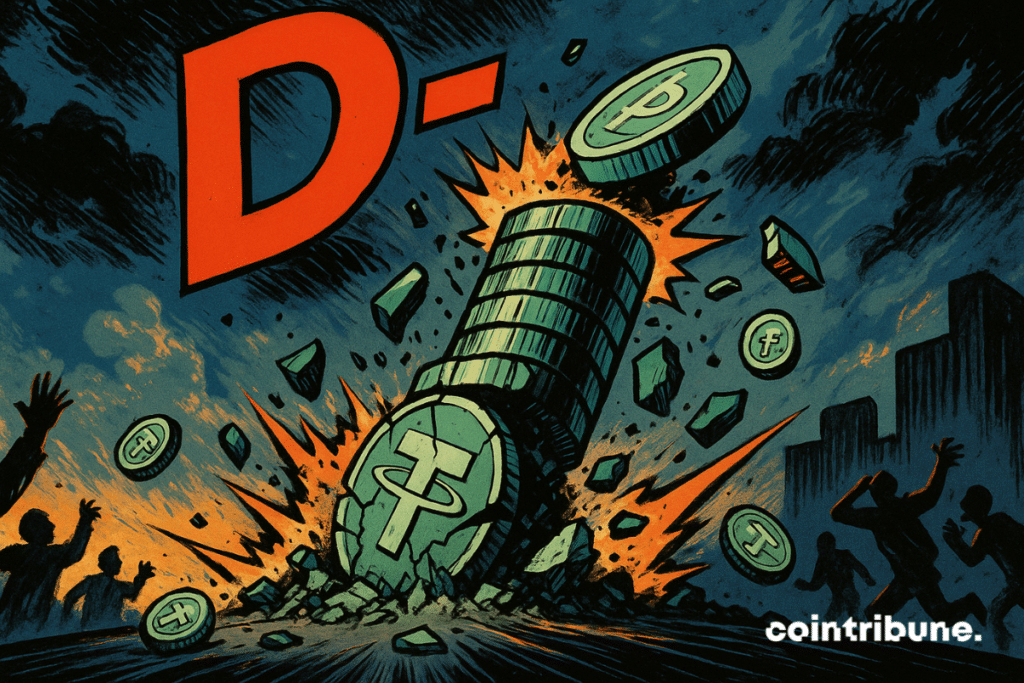USDT’s Stability Challenged By S&P Report
S&P Global Ratings has just downgraded USDT to its lowest stability level. A rare decision targeting the world’s most used stablecoin and raising doubts about its ability to maintain its peg to the dollar. At a time when regulators are tightening the noose around cryptos, this evaluation revives debates on the solidity of Tether’s reserves and the systemic risks stablecoins pose to the entire market.

In brief
- S&P Global Ratings assigns USDT the lowest stability rating on its scale, a first for a stablecoin of this scale.
- The agency questions the composition of Tether’s reserves, seen as too exposed to volatile assets like Bitcoin, gold, or loans.
- The lack of independent audits and the permissive regulatory framework in El Salvador reinforce doubts on Tether’s model robustness.
- In response, Tether rejects the report, defends the robustness of its reserves, and criticizes the relevance of criteria used by S&P.
The stability of USDT questioned
S&P Global Ratings has assigned USDT, a stablecoin issued by Tether, the lowest rating on its stability scale, highlighting risks deemed structural in the company’s reserve model, while the issuer aims for a $500 billion valuation.
The agency questions Tether’s ability to maintain parity with the dollar under certain market conditions, especially during stress periods. It states that the reserve portfolio includes a proportion deemed too high of volatile or illiquid assets.
“A decline in bitcoin price or the value of other risky assets could reduce collateral coverage,” the report specifies. This statement particularly targets Tether’s exposure to certain assets whose stability is uncertain.
Here are the main factors challenged in S&P’s analysis :
- 5.6 % of reserves are invested in bitcoin, which exceeds the estimated margin of 3.9 %, in a model with 103.9 % collateralization ;
- The presence of risky assets in the reserves: gold, loans, corporate bonds, all more volatile than US Treasury bills ;
- A lack of comprehensive independent audits, considered problematic for an asset of this scale ;
- Lenient regulation : Tether is regulated in El Salvador via the National Commission of Digital Assets (CNAD), whose standards are viewed as permissive by S&P.
Despite this, the report acknowledges that 75 % of USDT reserves are invested in US Treasury bills and other short-term instruments considered low risk.
However, this is not enough to offset the vulnerabilities mentioned, especially in a context of market instability or liquidity crisis. This decision marks a first in the public assessment of the robustness of a stablecoin of this size by a major financial rating agency.
Tether defends its model and rejects traditional rating criteria
In response to this symbolic setback, Tether reacted strongly, calling the S&P report “misleading.” In a statement, the company asserts that it “categorically rejects the characterization presented in the report,” adding that it “does not reflect the nature, the scale, nor the macroeconomic significance of native digital money.”
CEO Paolo Ardoino also criticized the relevance of evaluation models used by traditional agencies, recalling that these same methods had given favorable ratings to institutions that later went bankrupt: “classic models built for traditional financial institutions have historically led investors to put money in companies which, despite their ratings, collapsed,” he said.
Tether highlights massive figures to justify its solidity : over $112 billion in US Treasury bills, making the stablecoin issuer the 17th largest global holder of US sovereign debt, ahead of economic powers like Germany or South Korea.
The company also holds 116 tons of gold, which, combined with its ability to issue and redeem digital dollars globally, brings its operation closer to that of a real central bank, according to some analysts. These data, although partially acknowledged in the S&P report, are according to Tether largely underestimated in the analysis of its ability to maintain parity with the dollar.
The downgrade of USDT by S&P exposes tensions between the promise of stability and the reality of reserves. In an increasingly monitored market, stablecoins will henceforth need to combine transparency, robustness, and credibility to stay at the heart of digital exchanges.
Maximize your Cointribune experience with our "Read to Earn" program! For every article you read, earn points and access exclusive rewards. Sign up now and start earning benefits.
Diplômé de Sciences Po Toulouse et titulaire d'une certification consultant blockchain délivrée par Alyra, j'ai rejoint l'aventure Cointribune en 2019. Convaincu du potentiel de la blockchain pour transformer de nombreux secteurs de l'économie, j'ai pris l'engagement de sensibiliser et d'informer le grand public sur cet écosystème en constante évolution. Mon objectif est de permettre à chacun de mieux comprendre la blockchain et de saisir les opportunités qu'elle offre. Je m'efforce chaque jour de fournir une analyse objective de l'actualité, de décrypter les tendances du marché, de relayer les dernières innovations technologiques et de mettre en perspective les enjeux économiques et sociétaux de cette révolution en marche.
The views, thoughts, and opinions expressed in this article belong solely to the author, and should not be taken as investment advice. Do your own research before taking any investment decisions.